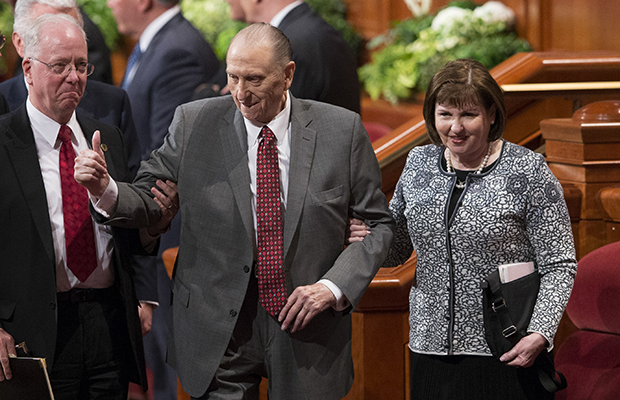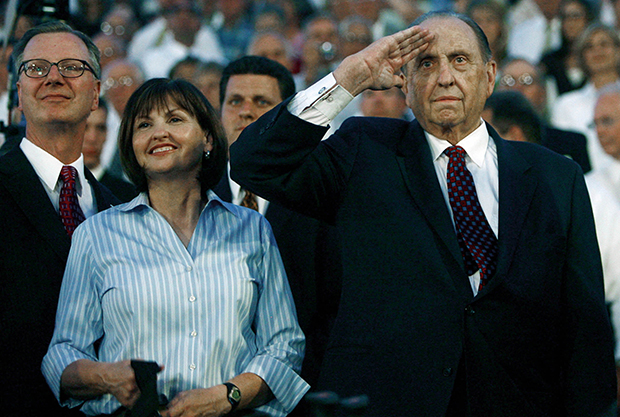Prophet Found Joy in Serving Others, Daughter Says
Contributed By Sarah Jane Weaver, Church News editor; Tad Walch, Deseret News staff writer

President Thomas S. Monson and his daughter, Sister Ann M. Dibb, exit the Conference Center in Salt Lake City following the Sunday morning session of the 187th Annual General Conference on Sunday, April 2, 2017. Photo by Scott G Winterton, Deseret News.
“He was full steam ahead his whole life, and he was worn out. They weren’t making parts any more for Tom Monson.” —Ann M. Dibb, daughter
President Thomas S. Monson, a “whirlwind of a man” and a leader of enormous compassion, found great joy during his final years doing what he had done so many times before—visiting those who were sick, lonely, or needed lifting.
This occurred even as his own physical health and memory were diminishing, said his daughter, Ann M. Dibb.
Serving “was how he could be of good cheer,” she said.
President Monson, 90, died peacefully Tuesday, January 2, of causes incident to age, after serving 54 years as an Apostle, including a decade as President of the Church.
Speaking of her father days after his death, Sister Dibb—a former counselor in the Young Women General Presidency who cared for her father in his final years—said the most valuable thing she did with him was make personal visits to old friends and others who were sick or needed lifting. There was beauty and power in those moments, she said.
Those visits were important to not only the people who needed a visit but also to her father, who needed to serve. “He was there for what mattered,” she said.
When the visits were over, said Sister Dibb, President Monson was happy. He “was whistling.”

Ann M. Dibb speaks during funeral services for her mother, Sister Frances J. Monson, at the Salt Lake Tabernacle in Salt Lake City, Thursday, May 23, 2013. Photo by Ravell Call, Deseret News.

President Thomas S. Monson helps his daughter, Sister Ann Dibb, with the trowel during the cornerstone ceremony at the Twin Falls Idaho Temple on August 24, 2008. Photo by Scott G Winterton, Deseret News.
Some of those visits were to friends who were at the end of their life—friends who were once powerful, but now infirm. “He would go and take their hand,” said Sister Dibb. “He would talk to them as though they were at their finest moment.”
President Monson always treated others the way he would want to be treated himself, Sister Dibb explained. He would ask himself, “What would I want someone to do for me?”
In recent years, as with so many of his friends, President Monson’s body grew frail and his memory dimmed.
Months before his death, because of the limits of age, President Monson stopped attending meetings at the Church offices and participating in the daily operations of the Church. He was hospitalized for dehydration after delivering his last general conference address in April 2017.
“He had a physical body that had fulfilled its purpose,” said Sister Dibb, who compared President Monson’s body to a vehicle with 400,000 miles on it. “He was full steam ahead his whole life, and he was worn out. They weren’t making parts any more for Tom Monson.”
Referencing a phrase penned by Scottish author James Barrie, and quoted often by President Monson—“God gave us memory that we might have roses in December”—Sister Dibb said her father’s final months were challenging.
“He was a man who believed in creating memories,” she said. Possibly his memories were taken from him because “this was Tom Monson’s test.”
Sister Dibb said she found solace in one of President Monson’s favorite scriptures, “Trust in the Lord with all thine heart” (Proverbs 3:5).
“He still needed to feel useful and of value—he needed to serve and to minister.”
Ministering was not just part of President Monson’s nature, but it was also part of his family heritage, said Sister Dibb. During the 1930s, transient men riding the rails always found a meal in the Monsons’ west Salt Lake City home. President Monson’s mother, Gladys Condie Monson, had the men wash and dry with the same towel the family used. They ate the same food, at the same table, on the same plates as the rest of the family. She always encouraged them to write home.
President Monson’s father, G. Spencer Monson, also found ways to quietly mentor his son. He was very “understated,” said his granddaughter. When he made a comment everyone knew they should pay attention.

President Thomas S. Monson claps as the University of Utah unveils the newly refurbished Enos A. Wall Mansion and names it the Thomas S. Monson Center in Salt Lake City on Wednesday, August 24, 2016. The mansion serves as home to the Kem C. Gardner Policy Institute. President Monson is flanked by President Dieter F. Uchtdorf, a counselor in the First Presidency, and his daughter, Ann Dibb. Photo by Jeffrey D. Allred, Deseret News.
One such lesson came when President Monson as a young boy tried to raise money to buy pigeons. During a visit to his great aunts’ house, he worked and they paid him for the chores.
On the ride home, Spencer Monson asked his son, “Did you accept money from my aunties?” When Tom said, “Yes,” his father said only, “I am disappointed in you, Tommy.”
The next time President Monson visited his great aunts “he gave the money back and did even more work,” said Sister Dibb.

President Thomas S. Monson and his daughter, Sister Ann M. Dibb, exit the Conference Center in Salt Lake City following the morning session of the 187th Annual General Conference on Saturday, April 1, 2017. Photo by Scott G Winterton, Deseret News.
In a video made of President Monson’s life soon after he became Church President, he is pictured pointing his finger and explaining, “The lesson was not lost on me.”
Sister Dibb said she loves the clip. It exemplifies the way her father responded to his father’s reproof and so much more.
“It was not lost on him,” Sister Dibb said. He could observe a situation, recognize what needed to be done or changed, and then do it. “He only needed to learn a lesson once.”
Sister Dibb said her father recognized “how people tick.” He knew everyone wanted to feel acknowledged, safe, and valued. “There are times when we all may need someone else’s help.”
Sister Dibb said she often heard her father say, “If the Lord has an errand to be run, I want the Lord to know Tom Monson will run that errand for Him.”

President Thomas S. Monson waves to the crowd as he exits with his daughter, Sister Ann M. Dibb, from a session of the 186th Annual General Conference in Salt Lake City at the Conference Center on Sunday, April 3, 2016. Photo by Scott G Winterton, Deseret News.
Sister Dibb said her father always looked to the Savior. He considered what the Savior would do and that became his lifetime pattern.
“Who did he look to as his example? It was the Savior. … The Savior was a good teacher. He was forgiving. He was loving. He was perceptive as to what a need might be. He blessed and He healed and He taught.”
Sister Dibb said she saw many of these same traits in her father. She believed they were spiritual gifts that were made manifest and magnified “because the lesson was not lost on Tom Monson.”
Sister Dibb said her father always thought of people in a positive manner and saw them as “they may become.”
He often said, “We need to bear in mind that people can change. They can put behind them bad habits. They can repent from transgressions. They can bear the priesthood worthily. And they can serve the Lord diligently.”
Sister Dibb said her father was patient in watching the process of human change.
“If they changed right then or later, it didn’t matter,” she said. “He was patient. He had absolute confidence they would. Sometimes I’d say, ‘Really, Dad? Look at the way this is going,’ but he believed in the best in each individual. He had a lifetime of experience of seeing people change.”

From left, President Thomas S. Monson waves to the crowd with his wife, Sister Frances Monson, and his daughter, Sister Ann M. Dibb, at his side at the conclusion of the morning session of the 179th Semiannual General Conference at the Conference Center in Salt Lake City, Utah, Saturday, October 3, 2009. Photo by August Miller, Deseret News archives.
Sister Dibb said her father, who spent his life surrounded by people—unless, of course, he was fishing—was always concerned with the individual. “He believed in their goodness. He believed in repentance. He knew they could change. And if Tom Monson could be along, encouraging, assisting, listening, doing what the Lord would have him do in helping them to change and receive all the blessings, that’s where he was going to be.”
It was pleasing to him to recognize the Lord trusted him to help another of His children, said Sister Dibb.
Once President Monson made a friend, he was a friend forever, added Sister Dibb.
If he recognized that someone needed extra attention he would visit that friend, not once, but “over and over again.”
Much of that ministering was made possible because of the support of her mother, Sister Frances Monson—who encouraged and enabled President Monson in his service.
As a child, Sister Dibb remembers that everything began when her father walked in the door. He had his briefcase “and it was always full,” she said, noting that he would ring the doorbell several times as he walked in “almost like an announcement that he was home.”

President Thomas S. Monson salutes as he and his daughter, Sister Ann Dibb (center), and her husband, Roger Dibb, attend the cultural celebration for the Twin Falls Idaho Temple on August 23, 2008. Photo by Scott G Winterton, Deseret News.
As a 12- or 13-year-old boy in a congregation, he prepared a talk and read it in church. Afterward, a local priesthood leader told him the talk was wonderful but that next time he needed to memorize it.
“Every talk he gave after that was memorized,” Sister Dibb said, “up until he joined the First Presidency [in 1985] and had to give multiple talks at each general conference.”
But he struggled at the end of his life remembering if he had just told a story. “His memory was incredible through the years, and his ability was diminished,” Sister Dibb said. “It was difficult to see this because it would hurt him to be recognized that way.”
The remedy to that hurt was doing what was core to President Monson—visiting and serving, said Sister Dibb. It was evident, even in his aged years, that he was an answer to the prayers of others, she said.
He knew as he listened and observed he might perceive who needed help or simply a friendly hello, she said. “All of this was wrapped up in a ‘whirlwind of a man.’”

President Thomas S. Monson shakes hands with his counselors, President Henry B. Eyring and President Dieter F. Uchtdorf, on Tuesday, August 15, 2017, in his Salt Lake City apartment as he nears his 90th birthday on August 21, 2017. Photo by Scott G Winterton, Deseret News.
